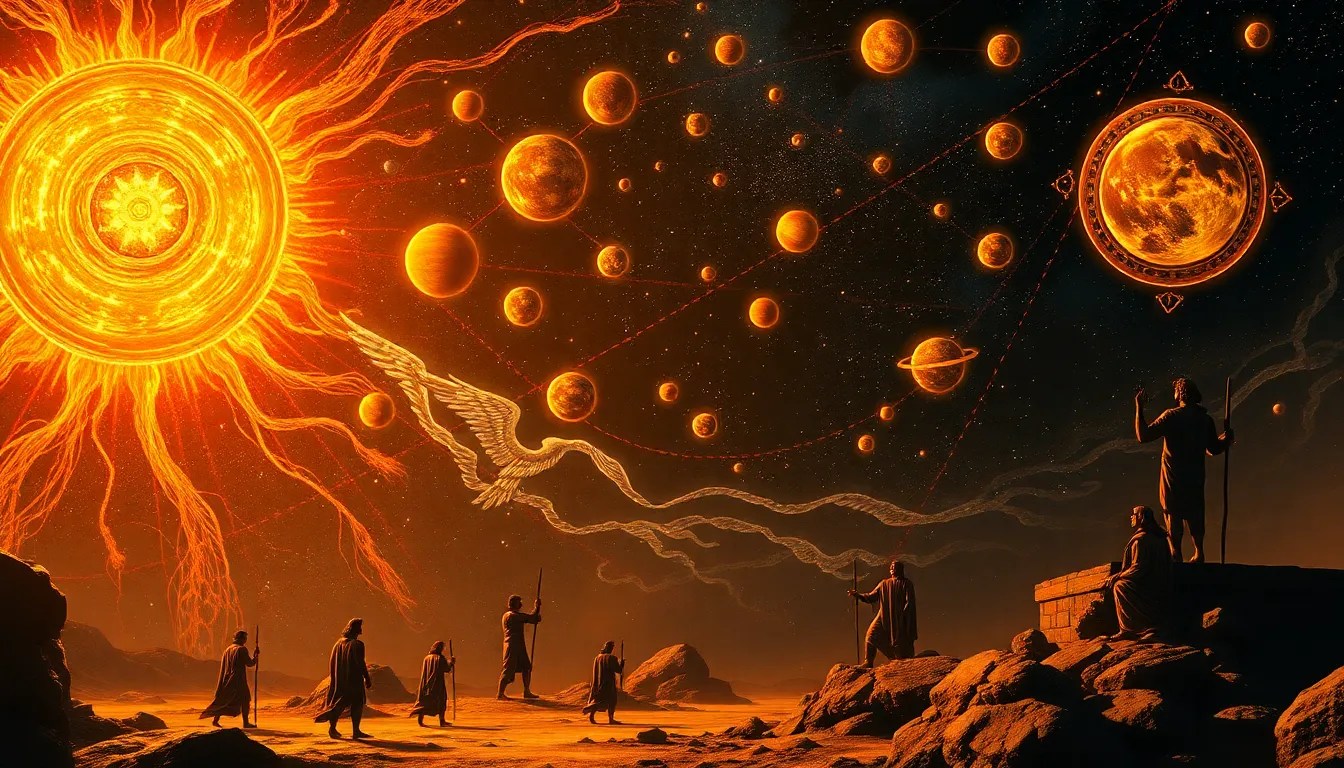Marduk’s Creation of the Celestial Bodies in Enuma Elish
I. Introduction to Enuma Elish
Enuma Elish is one of the most important creation myths from ancient Babylonian mythology. This epic poem, written in Akkadian, narrates the origins of the world and the establishment of divine order. At the heart of this creation story is Marduk, a powerful deity who rises to prominence among the gods and ultimately becomes the creator of the cosmos.
The significance of Marduk in Babylonian mythology cannot be overstated. He represents not only strength and leadership but also the principle of order over chaos. This article will explore Marduk’s pivotal role in the creation of celestial bodies, illustrating how his actions shaped both the universe and the human experience.
II. The Context of Creation: Chaos and the Primordial World
Before creation, there existed a chaotic primordial world, characterized by a vast and untamed ocean. This chaos is personified by Tiamat, the goddess of the ocean, and Apsu, the god of freshwater. Together, they embody the primordial forces of chaos and confusion, representing the potential for creation but also the threat of destruction.
In this tumultuous environment, Marduk emerges as a hero, chosen by the younger gods to confront Tiamat. His rise to power is marked by his extraordinary abilities and his willingness to take on the challenges posed by the chaotic forces of the universe.
III. The Battle Between Marduk and Tiamat
The confrontation between Marduk and Tiamat is a central theme in Enuma Elish. Marduk’s challenge to Tiamat’s authority signifies a struggle between order and chaos. Armed with powerful weapons and the blessing of the other gods, Marduk faces Tiamat in a fierce battle that has profound implications for the cosmos.
The significance of this battle lies not only in Marduk’s triumph but also in the symbolic representation of the struggle for dominance over chaos. The consequences of Marduk’s victory are far-reaching; it leads to the establishment of a structured universe and the creation of the celestial bodies that govern the heavens.
IV. Marduk’s Victory: The Creation of the Cosmos
Following Marduk’s victory over Tiamat, he takes decisive actions to create the cosmos. He splits Tiamat’s body in two, using one half to form the heavens and the other half to create the earth. This act symbolizes the transition from chaos to order, as Marduk establishes a structured universe governed by divine laws.
Marduk’s triumph is not merely a victory over chaos; it represents the establishment of balance and harmony in the universe. His actions create a framework that allows life to flourish and the natural order to prevail.
V. The Creation of Celestial Bodies
As part of his creative acts, Marduk brings forth various celestial bodies that play crucial roles in the Babylonian worldview. The specific creations include:
- The Heavens and the Earth: Marduk forms the sky and solid ground, creating a space for life to exist.
- The Stars, Moon, and Sun: He establishes the celestial bodies that govern time and seasons, providing light and guidance to humanity.
The purpose of these celestial bodies in Babylonian cosmology is to regulate time, mark the seasons, and guide agricultural practices. Marduk’s establishment of time is vital, as it allows for the organization of society and the synchronization of human activities with the natural world.
VI. Marduk’s Role in Maintaining Cosmic Order
Marduk’s influence extends beyond creation; he is also seen as a guardian of cosmic order. The connection between Marduk and the divine order is integral to maintaining balance within the universe. The celestial bodies he created serve as symbols of this order and have a direct impact on human life.
The movement of the stars, the phases of the moon, and the cycles of the sun dictate agricultural practices, religious observances, and daily activities in Babylonian society. Marduk’s role as a symbol of balance and harmony resonates deeply within the cultural and spiritual practices of the Babylonians.
VII. Symbolism and Interpretation of Marduk’s Creation
The creation narrative of Marduk also conveys profound symbolism, particularly the dichotomy of light versus darkness. Marduk’s triumph over Tiamat is often interpreted as the victory of civilization, knowledge, and order over chaos, ignorance, and destruction.
The influence of Marduk’s creations is seen in later mythologies, where similar themes of creation and cosmic order are echoed. Modern interpretations of Marduk’s narrative often highlight the importance of overcoming adversity and establishing a sense of purpose and order in one’s life.
VIII. Conclusion: The Legacy of Marduk’s Creation
In conclusion, Marduk’s role in the Enuma Elish is central to understanding Babylonian mythology and its worldview. His actions in creating the celestial bodies not only shaped the cosmos but also established a framework for human existence. The enduring impact of Babylonian mythology is evident in its themes of order, chaos, and the perpetual struggle for balance.
Reflecting on these myths today, we find relevance in their exploration of existence, the natural world, and the human condition. Marduk’s legacy as a creator and maintainer of cosmic order continues to resonate, reminding us of the importance of harmony in our lives and the world around us.



